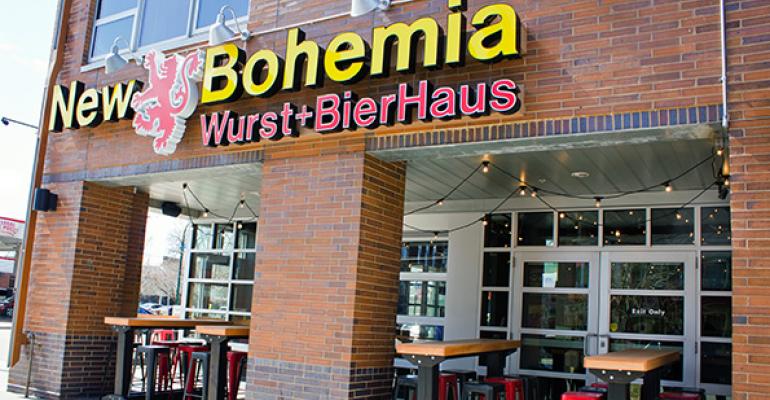The jackalope is a jackrabbit with horns popularized by some Wyoming taxidermists in the 1930s. It is, by all accounts, a mythical creature. So what is it doing on the menu of New Bohemia Wurst + BierHaus, the Minneapolis-based sausage-and-beer chain?
In reality, the sausage is made from rabbit, antelope and pork. It’s among a selection of attention-getting specialty sausages that go beyond traditional pork and chicken, and gives New Bohemia more of a kick. Some other sausages include alligator, rattlesnake, elk and wild boar.
“It’s a conversation starter,” said Brian Ingram, corporate operating officer for the five-unit chain. “It gets people talking about the food.”
New Bohemia hopes that it starts a conversation around the country. The chain, which opened its first unit just outside downtown Minneapolis in 2012, now has five restaurants, plus a food truck, in Minnesota, and is looking to expand faster and in more markets across the U.S.
The chain plans to have 10 units by the end of the year, and hopes to have as many as 25 restaurants by the end of next year, with locations added either via franchising or joint-venture deals.

Doing so would bring its unique blend of sausage and beer, served in a fast-casual format, to many more markets.
New Bohemia has been designed to look like a German beer hall, with long, communal tables and a huge selection of beers. The goal is to give the restaurants a “sense of community,” Ingram said. “We have a lot of singles and a lot of Millennials. We try to get them to talk with each other.”
Longtime restaurateur Jeff Bornmann, who has worked with Minneapolis-based restaurant creator Steve Schussler for the past 10 years, helped develop New Bohemia, and sees growing demand for local and craft beers.
“We wanted a new type of craft beer hall,” said Bornmann, the chain’s senior vice president of development and self-described Midwest Sausage King.

New Bohemia has 28 beers on tap, displayed on an 8-inch brewers’ pipe behind the bar, and every location has a selection unique to its particular market. Future expansion possibilities include cities like Minneapolis, where craft beer is notably popular, as well as Wisconsin, Denver and Southern California.
“Our whole thing is to showcase local beer,” Ingram said. The beer, much like the unique selection of sausage, is a draw. “They want to come in and taste the watermelons, the coconuts and the stouts.”
The company often uses a DJ at night to run trivia contests and “Disco Bingo” games in which winners cannot collect their prize without dancing first.
“You come in at night, there’s a boisterous sense of community,” Bornmann said. “It’s a community gathering place in a fast-casual format. People in the neighborhood are looking for a place to hang out.”
But, Ingram noted, “We’re not a bar.” New Bohemia is eager to lure families, and it doesn’t offer spirits. “When shots are on the table, everything changes,” Ingram said. “The atmosphere changes dramatically if you bring in liquor.”
New Bohemia has a remarkably simple menu. Its sausages come from suppliers who can obtain meats from wild game, but also from pork and chicken. And while customers might start with the rattlesnake rabbit sausage at first, they often shift back to less experimental flavors like Buffalo Chicken Blue Cheese.
“They begin with some of the wild game exotics, and then they find sausages they really love,” Ingram said.
But for all of the sausage varieties, the menu itself is limited to sausage, a few sides, like fries, and giant pretzels.
The giant pretzels are popular with the late-night bar crowd. And they’re huge, weighing in at more than three pounds.
“We found a factory in Milwaukee that makes giant Bavarian pretzels,” Ingram said. “We sell a lot of giant pretzels at 1:30 in the morning.”
There are some complex elements to the menu. All of the mustards are made in-house, and the staff is trained to brine mustard seeds and grind them in-house. Restaurants also hand-cut fries.
Still, the menu and the concept are simple, designed to be scalable and profitable. Executives say labor costs are around 20 percent. The general manager is a working position that operates the register and busses tables.
“It’s not a salaried position where you’re a figurehead,” Bornmann said.
The low labor costs and simplified operation, along with a careful selection of location, are all designed to enable the chain to be profitable at relatively low unit volumes.
“We don’t have to make $2.5 million per year to make money,” Bornmann said.
Contact Jonathan Maze at [email protected]
Follow him on Twitter: @jonathanmaze




